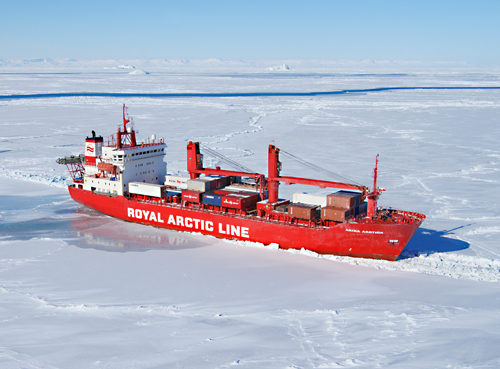
For more than 20 years (since 1993 to be exact) Royal Arctic Line has been a premier provider of specialist services and skills to customers in Greenland and the wider Arctic region. Wholly owned by the Government of Greenland, Royal Arctic Line and its vessels hold an exclusive concession for the transportation of general supplies by sea to and from Greenland, and between the various Greenlandic towns and settlements.
Through its subsidiary, Royal Arctic Bygdeservice, goods are also carried to all the settlements, while Royal Arctic Havneservice handles operations in the 13 biggest ports and harbours in Greenland, and at the same time represents the port authority on behalf of the state in these ports and harbours. Forwarding activities such as air freight, combined air/sea freight and consolidated are undertaken by Royal Arctic Logistics.
Furthermore, the group is also a major supporting player within Greenland’s oil and mineral exploration sectors with activities in these fields being undertaken by Arctic Base Supply, a business co-owned by Royal Arctic Line and Norwegian Norsea Group. A quick glance over the aforementioned services really does highlight why the company has come to be seen as one of Greenland’s most important lifelines.
Greenland, and indeed the other countries that exist within or between the Arctic and Atlantic Oceans, of course comes with its own unique environment and climate, and thus its own unique challenges. It stands to reason therefore that not just any company, shipping or otherwise, is suited for servicing the country. Rather it takes those with market leading experience, knowledge and capabilities to earn business in this remote part of the world.
“What you have with much of Greenland is an environment typified by difficult weather and geological conditions, and little or nothing in the way existing infrastructure,” explains Royal Arctic Line’s Commercial Director, Niels Clemensen. “What we have as a business is a large degree of competency, experience and understanding of what it is like to operate within the Arctic. Alongside this we have the physical assets of a fleet of vessels and equipment specifically designed with the Arctic environment in mind.”
The fleet that Clemensen speaks of consists of ten ships, each meticulously designed to overcome the challenges that operating in the Arctic possesses. The company’s biggest ocean-going vessels and feeder ships are of the highest Baltic ice classification and have been specially-built with double hulls and high freeboard so they can sail in Arctic waters. All the ships are fitted with cranes and are supplemented with the shipping company’s barges.
“Our vessels are designed especially for carrying out trade to and from Greenland, and for sailing on the North Atlantic, which is of course a very rough sea,” Clemensen continues. “All equipment on board is designed to operate down to -30 degrees, which is the standard that we work to given that we understand the demands that can be placed on this equipment, especially during the Arctic winter. It is vital to remember at all times also that when working in this part of the world there is almost never a time when there isn’t a huge distance between yourself and the nearest spare part or support vessel. With that in mind the utmost attention to detail goes into each operation our vessels conduct.”
Arriving at Greenland in the search for minerals presents the industry with the challenge of overcoming a remote landscape lacking in infrastructure. Fortunately for these companies Royal Arctic Line and its subsidiaries are more than used to operating under such demanding conditions. The company prides itself on the wide range of logistical and transportation services it can offer its customers. Particular solutions of note include the transport of fuel, machineries and special cargo, regular connections to the US and Canada, consolidation of cargo before shipment, monitoring and surveying, ice management, forwarding services and preparation for sling operation from barges. To date Royal Arctic Line has been a major provider of logistics support during the construction and operation of several notable mines such as the Olivine Mine and Nalunaq Gold Mine in Greenland.
“The services and equipment we have available to the mineral sector are varied enough to support all stages of mineral development, be it the construction, production or operational stage of a mine’s life,” Clemensen enthuses. “The most important thing to remember is that all of these mines are established in the most remote of locations, miles from what few established towns there are and with practically no infrastructure in place to support their growth. What makes us unique is that we are able to reach such locations, places that other shipping companies cannot, and we have the built in knowledge, systems and capabilities required to immediate begin supporting customers in the mineral industry regardless of what stage of development they find themselves.”
Royal Arctic Line has also taken the initiative in examining other business opportunities, both in Greenland and further afield. “We also recognise the need to target specific niche markets that are best suited to benefit from our fleet and our unique capabilities,” Clemensen highlights. “So, for example, we have spent the last five years providing supply services to Antarctic bases belonging to the likes of Belgium, Germany and the UK, to name a few countries, while one of our vessels is regularly leased out to the Norwegian Polar Institute to supply their base. These are the kinds of niche, yet hugely important, jobs that our vessels can undertake and that those belonging to other container lines are unable to.”
Written by Will Daynes, research by Vincent Kielty



 RoyalArctic-Greenland-Mining-July14-Bro-s.pdf
RoyalArctic-Greenland-Mining-July14-Bro-s.pdf









